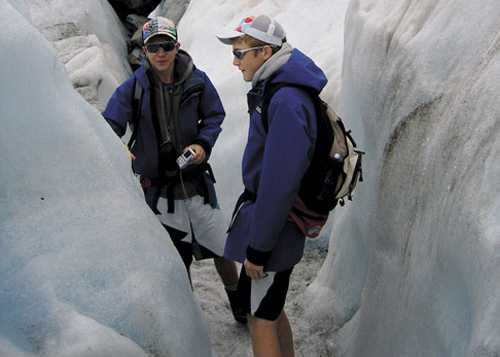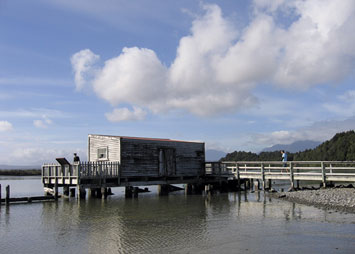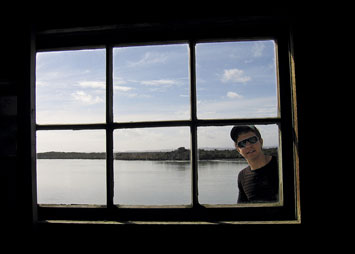
Into The Wild West - Franz Josef Glacier
There’s something pleasantly hypnotic about driving down a West Coast highway, with fern, rimu, ponga and beech flashing past on either side like living wallpaper in a long green corridor.
Amanda Cropp takes her family out of town to climb the South Island's Franz Josef glacier.
Last time we headed ‘over the hill’ from Christchurch, I talked my husband Mark and sons Ben and Nic into going caving. This time they very generously agree to accommodate my ice obsession and our destination is Franz Josef where I will fulfill a long-held ambition to climb the glacier.
As we zip across the Canterbury plains, the Alps have a light sprinkling of snow and look like an old bloke with grey whiskers making a sad attempt at designer stubble.
At the Mount White Bridge we join a convoy made up of a camper van, a stock truck, a vintage car, and a logging truck. Near Bealey, the logger overtakes the stock truck on a blind corner leading up to a one-lane bridge, and we can only assume the driver has x-ray vision.
At Arthur’s Pass we come across a large group of Model A Fords with old-fashioned trunks strapped to their tailgates, well prepared for a long distance rally.
It’s a chilly day and the vintage open-window variety of air conditioning looks deeply unappealing. I’ll stick to my Mitsubishi Outlander and its heated seats, especially given that we are about to descend into Otira.
The teenage sons always refer to the former railway settlement as O-Terror because it always looks so depressingly cold and down at heel. Today, a redeeming feature is a giant metal weta sculpture for sale in the old works depot.
Soon it’s clear that we have crossed the east-west boundary. There’s a sign advertising psychic readings, pongas and soap and, at Kumara, I spot the first of many anti-1080 placards protesting attempts to rid the bush of possums through use of the controversial poison.
We take a break in Hokitika, admiring the glowing rainbow colours on display in the glass gallery and browsing in a greenstone factory where the whine of carvers’ drills sounds unnervingly like a dental surgery.
The walkway along the waterfront leads to a replica of the Tambo, one of the many ships that came to grief on the nearby sandbar. Seen in silhouette from the Hokitika bridge, it looks deceptively picturesque. Close up, it’s a bit tacky and its main function seems to be acting as a prop for young female tourists pretending to be Kate Winslet in the Titanic movie.
In Ross, the streets are completely deserted and the City Hotel seems a bit of a misnomer, but the huge opencast gold mine on the outskirts of the town is abuzz with trucks and diggers. Mark says: “there’s gold in them thar hills”.
On the windy road through the Mount Hercules reserve, the driver checks to see if anyone is feeling queasy. Many years ago Ben neatly threw up into his denim baseball cap on a particularly windy part of the Lewis Pass where stopping wasn’t an option, but with net-sided caps the fashion now, I’m grateful their carsickness days are over.

In Hari Hari our interest is piqued by a sign advertising a display about aviator Guy Menzies who, we discover, made the first solo crossing of the Tasman in 1931. Along with a replica of his aircraft there’s a description of his venture, which ended somewhat ignominiously when he mistook a local swamp for a landing strip and found himself upside down in the muck.
We roll up at Glenfern Villas just north of Franz Josef about 5pm and get an early night, so we’re ready to tackle a half-day trip up the glacier. It’s a two and a half kilometre walk to the base of the glacier. Although guide Dean warns it’s a tough climb up a zigzag track to the point where we don our crampons, we think it’s a doddle.
The ice immediately ahead of us is grey and looks dirty because a patch of moraine in the centre of the glacier regularly spits up rocks and gravel. Further up, the ice is cleaner and we admire the palette of blues, as we tramp down the centre of crevasses, our crampons crunching on shards of ice dislodged by guides wielding ice axes. It looks as if someone has attempted to build a path by emptying a huge tray of ice cubes.
After passing through a spectacular ice cave, we drop down onto a flat area and are just tucking into snacks when there is a sizeable rock fall on the rock face to our left. It creates a large dust cloud, and although we are in no danger, Dean suggests we move further away to avoid getting grit in our sandwiches.
The cost of our guided walk includes entry to the Franz Josef hot pools, a small but elegantly appointed complex in a beautiful bush setting. After a day on the mountain, the 40°C pool is bliss.
On the way home we fit in a 13km side trip to Okarito, the lagoon famous for its white heron colony, and less well known as the source of the enormous blue whale skeleton in the Canterbury Museum.

We walk on a beach liberally strewn with sculptural pieces of driftwood shaped up by the wild surf. My favourite bach is a one room affair called ‘Albert’s Hut’. The total permanent population here is 35, but back at the height of the first West Coast gold rush it was 1250, and the historic Donovan’s store that still stands in the main street (The Strand) sold everything from axe heads to pain killers.
We drop into Okarito Nature Tours for a coffee, which is served at an outdoor table with a complementary bottle of sandfly repellent, and soak up the absolute quiet. Down at the jetty, a lone white heron stalks the shallow waters of the lagoon and we vow to return one day to hire kayaks and explore this special place from the water.
Visitor information
Jacksons Tavern on SH73 is famous for its pies; the dinner menu includes Lamb Slam and Log of Hog.
Lake Mahinapua, 10km south of Hokitika, is a short drive from the main road. There are short walks around the lake and a model of an old paddle steamer to explore.
Glacier trips are operated by Franz Josef Glacier Guides.
Visit Okarito Nature Tours for kayak rentals or guided trips on Okarito Lagoon.
Reported by Amanda Cropp for our AA Directions Winter 2012 issue
